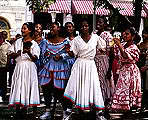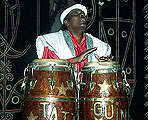Of all expressions of Art, music is undoubtedly
the one that has influenced more the personality of Cuban
people. It is said that the island's inhabitants speak singing,
dance while walking and woo with a love song. Music has
developed fast and strong. The Habanera, rhythm born from
the danza criolla and the contradanza, received its influence
from the tango in Argentina and other rhythms of South America.
Recent researches prove that in the contradanzas by Manuel
Saumell, the tempo of the habaneras could be heard, for
instance, in "La Tedesco", the first part is like the danzon,
which appeared later; in many of his music scores, song
and guajira were also outlined. Son and bolero arrived in
Havana from the eastern provinces, specifically Santiago
de Cuba. The bolero emerged at the beginning of this century
with great composers such as, Alberto Villalon and Sindo
Garay, influenced by Pepe Sanchez (who wrote the first one
"Tristezas", in 1883). Though the songs of the old trova
were boleros, best composers were Orlando de la Rosa and
Isolina Carrillo who left one of the most sublime gifts
of all times, the bolero "Dos Gardenias".
News about the son montuno dates back to
the second half of the 19th century. In 1920 "Havana's Sextet
" showed up at the high society salons in the capital. The
"Matamoros trio ", started their long-lasting and important
career in 1925 in Santiago de Cuba. They created some of
the classic Cuban songs: Son de la loma, Mariposita de primavera
y Lagrimas negras. Soon after, the first golden era of the
son arrived and dozens of septets and sextets came forth,
some of them began to make records with big North American
companies. Arsenio Rodriguez, Miguelito Cuni, Felix Chapotin
and Roberto Faz succeeded the first performers of son. Meanwhile,
orchestras like "Arcaño y sus maravillas" and "La Sensacion"
spirited balls in Havana playing danzones and charangas
during the '40s and '50s. Enrique Jorrin composed first
cha cha cha "La Engañadora" on 1950. Perez Prado made his
first mambo on 1952. The second splendour of son took place
in the '50s decade when a self-taught man from Cienfuegos
turned up: Benny More, who, years later would be acclaimed
"El Barbaro del Ritmo". This composer and singer revived
the traditional ways of Cuban music, leading the son montuno
to a concept of jazz band. The Cuban musician who had more
influence on the process of evolution of Cuban and Caribbean
music was Benny More. The "Van Van" orchestra of popular
dancing music, with a very typical and modern sonority,
was created in 1970. Year's later son offered its arrangements
to the Salsa, which also incorporated Caribbean rhythms
and sounds from the music of Latin (Cuban, Dominican and
Puerto Rican) communities in New York. Cuban salsa, very
well known today almost everywhere, reached its boom at
the end of the '80s and beginnings of the '90s when orchestras
like "Van Van" and "NG la Banda" grew solid and new, young
orchestras like "El Medico de la Salsa", "Paulo FG y su
elite" and "Isaac Delgado" came forth.
In the Late 90's and early 2000, Latin
Music, who's roots lie primarily in Cuban rhythms, has met
a massive revival worldwide with groups such as Ricky Martin,
Christian and the Buena Vista social Club. This rivival
outlines today's desires to return to the catchy rhythms
and agreeable melodies foundered in Cuba and now playing
worldwide at your local music store.
Viva la musica Cubana!










































